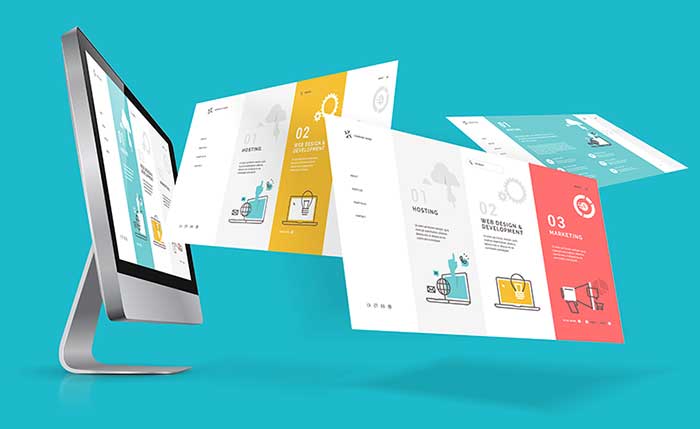The Ultimate Guide to Modern Web Design: Tips, Tools, and Trends
The Ultimate Guide to Modern Web Design: Tips, Tools, and Trends
Blog Article
Comprehending User Experience: Secret Concepts for Effective Web Design
In the world of internet style, recognizing individual experience (UX) is paramount to developing platforms that not just draw in but likewise keep individuals. Secret concepts such as instinctive navigation and efficient feedback mechanisms play essential duties in fostering user fulfillment. Additionally, factors to consider for ease of access guarantee that all users can engage with the material seamlessly. The subtleties of aesthetic design and the significance of iterative screening often remain neglected. As we check out these fundamental aspects, it becomes apparent that grasping UX is not merely an alternative however a need for success. What are the implications of disregarding these concepts?
Relevance of Individual Experience

In the world of web style, one can not undervalue the relevance of individual experience (UX) as a pivotal component that directly influences the success of a web site. When customers come across a user-friendly and appealing interface, they are extra most likely to explore the content, convert right into consumers, or share their experiences with others.
Additionally, the value of UX extends past mere looks. It incorporates the overall performance of a website, making sure that navigation is seamless and info is easily available. Sites that focus on UX are typically regarded as more reliable and trustworthy, which can have an extensive impact on conversion prices. On the other hand, poor UX can result in disappointment, causing high bounce prices and shed possibilities.
Ultimately, buying individual experience is not simply a design choice; it is a critical choice that can separate a brand in a crowded market. By focusing on UX, businesses can produce significant communications that reverberate with customers, leading the way for continual success in the digital landscape.
Usability Concepts
Efficient website design depends upon the application of key usability concepts that make sure an internet site is both straightforward and practical. Central to these principles is the principle of intuition, where individuals can navigate the site easily without comprehensive guideline. Clear navigating frameworks, including regular designs and well-labeled food selections, boost this instinctive experience, permitting users to situate info promptly.

Uniformity is equally crucial; maintaining harmony in layout elements, terms, and procedures across the website aids to minimize confusion. Customers should not have to relearn just how to communicate with various sections of the internet site.
In addition, error prevention and recuperation are essential for use. Internet sites must be designed to decrease the opportunity of customer errors, and when blunders happen, constructive and clear error messages ought to assist users in the direction of resolution.
Access Factors To Consider
Ensuring availability in internet style is paramount for developing inclusive digital experiences that accommodate all individuals, including those with disabilities. Accessibility considerations involve making websites that accommodate varied requirements, making it possible for users with aesthetic, acoustic, cognitive, or motor problems to navigate and engage effectively.
To achieve this, internet designers must follow established guidelines, such as the Internet Content Accessibility Standards (WCAG) These guidelines offer a structure for making material perceivable, operable, reasonable, and robust. Key practices consist of making certain sufficient shade comparison, supplying text alternatives for non-text material, and making certain key-board navigability.
Additionally, semantic HTML ought to be used to enhance screen reader compatibility, enabling individuals with visual problems to understand the framework and meaning of content without effort. web design. Supplying clear, succinct instructions and making use of uncomplicated language can additionally enhance functionality for individuals with cognitive handicaps
Regular access testing, including genuine individuals with disabilities, is important to recognize obstacles and boost the customer experience. By continue reading this focusing on accessibility, internet developers not only adhere to lawful criteria yet likewise foster an even more fair electronic landscape, ultimately benefiting every person with boosted functionality and involvement.
Aesthetic Design Aspects
A myriad of aesthetic design elements plays a vital duty in shaping user assumptions and experiences on an internet site. These aspects include shade schemes, typography, whitespace, design, and images, each adding to the total visual charm and efficiency of a site.

Color design stimulate emotions and can influence customer activities; for example, warm colors might develop a sense of necessity, while amazing shades commonly promote peace. Typography, on the various other hand, influences readability and can establish a brand's individuality - web design. The option of font design and dimension must align with the website's objectives and target market
Imagery, consisting of photos and icons, boosts narration and can significantly influence individual involvement. Top notch visuals create a feeling of expertise, while poor-quality images may diminish the customer experience.
Design and whitespace are just as crucial, as they lead customers via the content. A well-structured layout helps individuals locate details promptly, while ample whitespace prevents clutter, promoting a much more satisfying browsing experience.

Testing and Version
Customer screening and version are basic components of a successful website design process. These practices allow designers to collect important comments from real customers, guaranteeing that the last product satisfies their needs and assumptions. Customer testing involves observing just how genuine customers engage with a web site, determining usability problems, and understanding user habits. This straight feedback is crucial in revealing discomfort factors that may not appear throughout over at this website the design stage.
Model, on the various other hand, is the procedure of fine-tuning the more helpful hints layout based on the insights acquired from user testing. By making step-by-step adjustments and re-evaluating the layout, teams can boost performance, enhance aesthetic appeals, and enhance individual engagement. This intermittent strategy promotes a society of continuous renovation, permitting designers to adapt to customer needs and emerging fads effectively.
Furthermore, integrating both individual testing and version into the layout procedure leads to more informed decision-making and eventually leads to a more user-centered product. By welcoming these concepts, internet designers can produce extra user-friendly, appealing, and effective experiences that resonate with their target market, ultimately driving higher user complete satisfaction and retention.
Conclusion
In conclusion, customer experience is an essential component of reliable web style, incorporating use, access, and visual considerations. Constant testing and version serve as essential processes for recognizing and resolving individual discomfort factors, making sure that web designs remain versatile to advancing requirements.
In the realm of internet design, recognizing individual experience (UX) is vital to developing platforms that not just bring in yet likewise preserve individuals.In the world of internet layout, one can not take too lightly the relevance of individual experience (UX) as an essential aspect that straight influences the success of a site. User screening includes observing just how real individuals interact with a site, determining functionality concerns, and recognizing individual actions.In final thought, individual experience is an essential part of efficient internet layout, encompassing functionality, availability, and aesthetic factors to consider. Continuous testing and version serve as crucial processes for resolving and recognizing user pain points, making certain that internet designs stay versatile to progressing demands.
Report this page